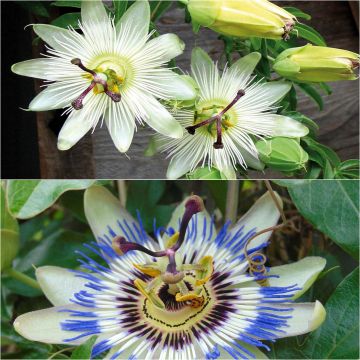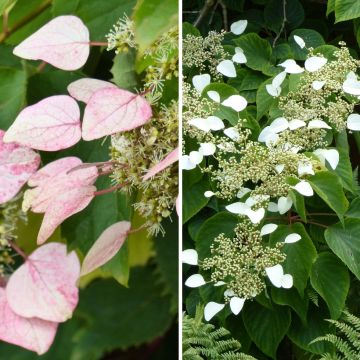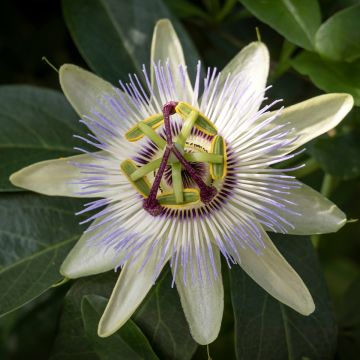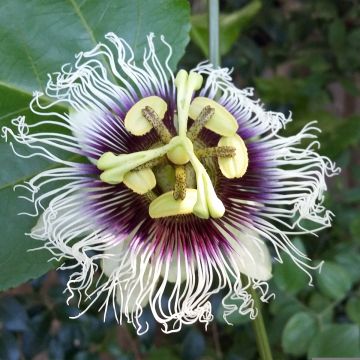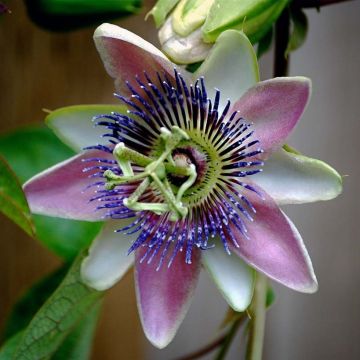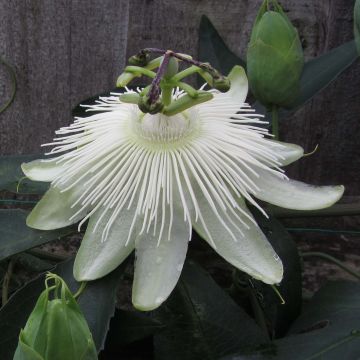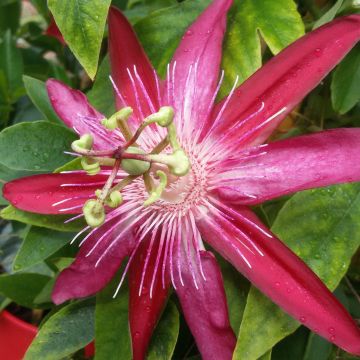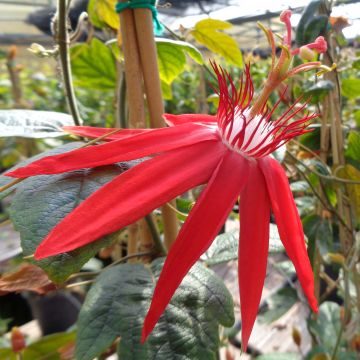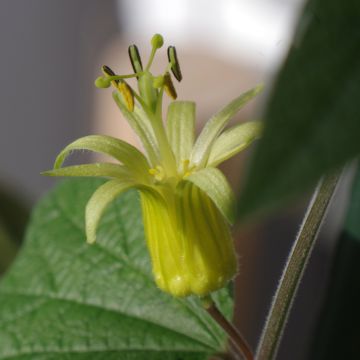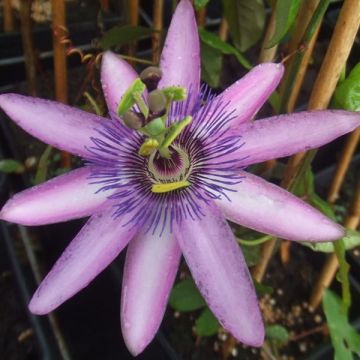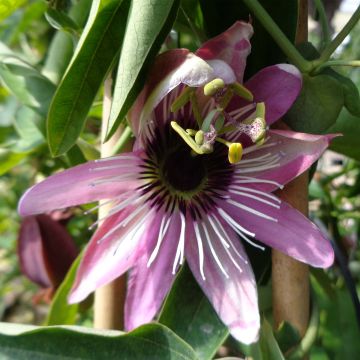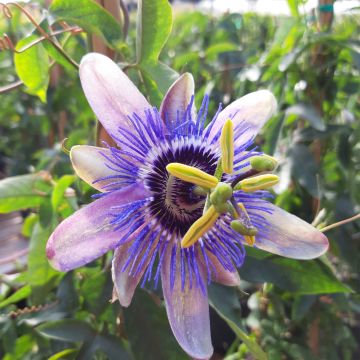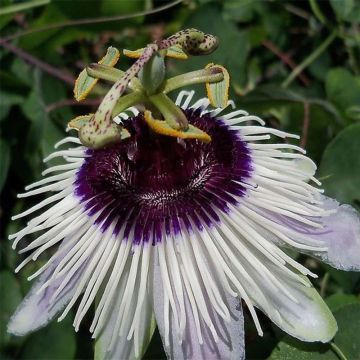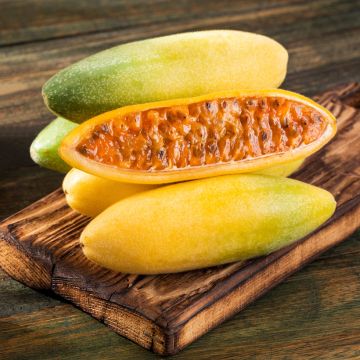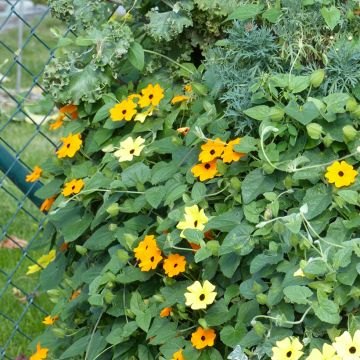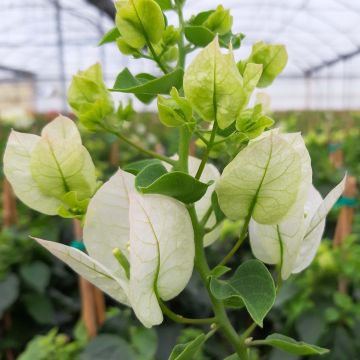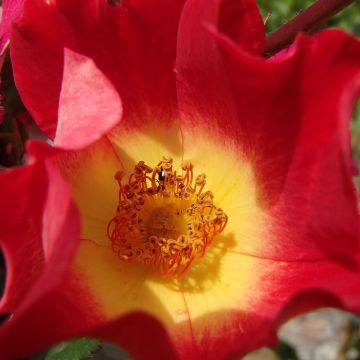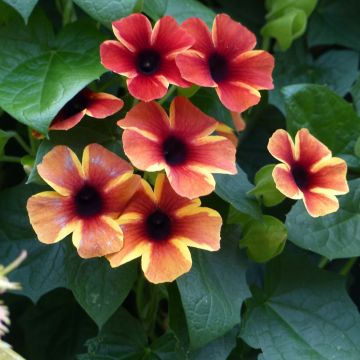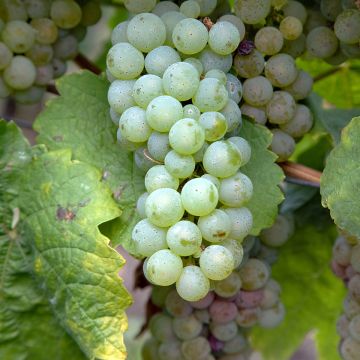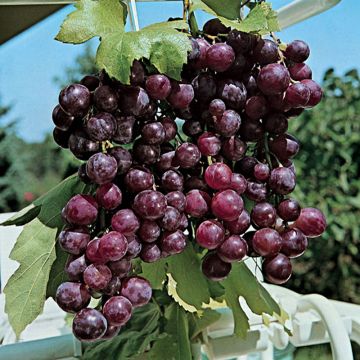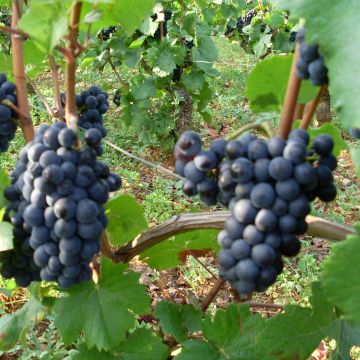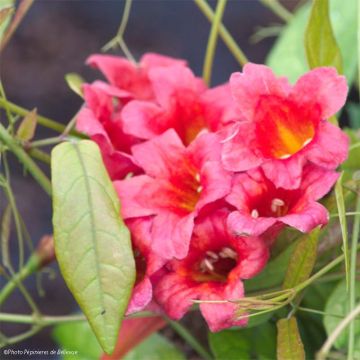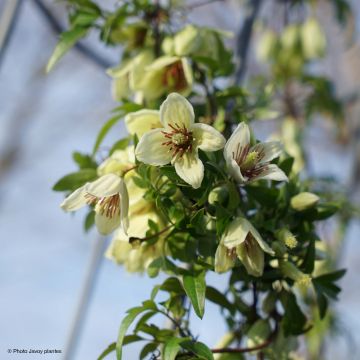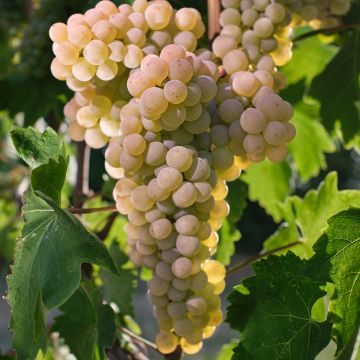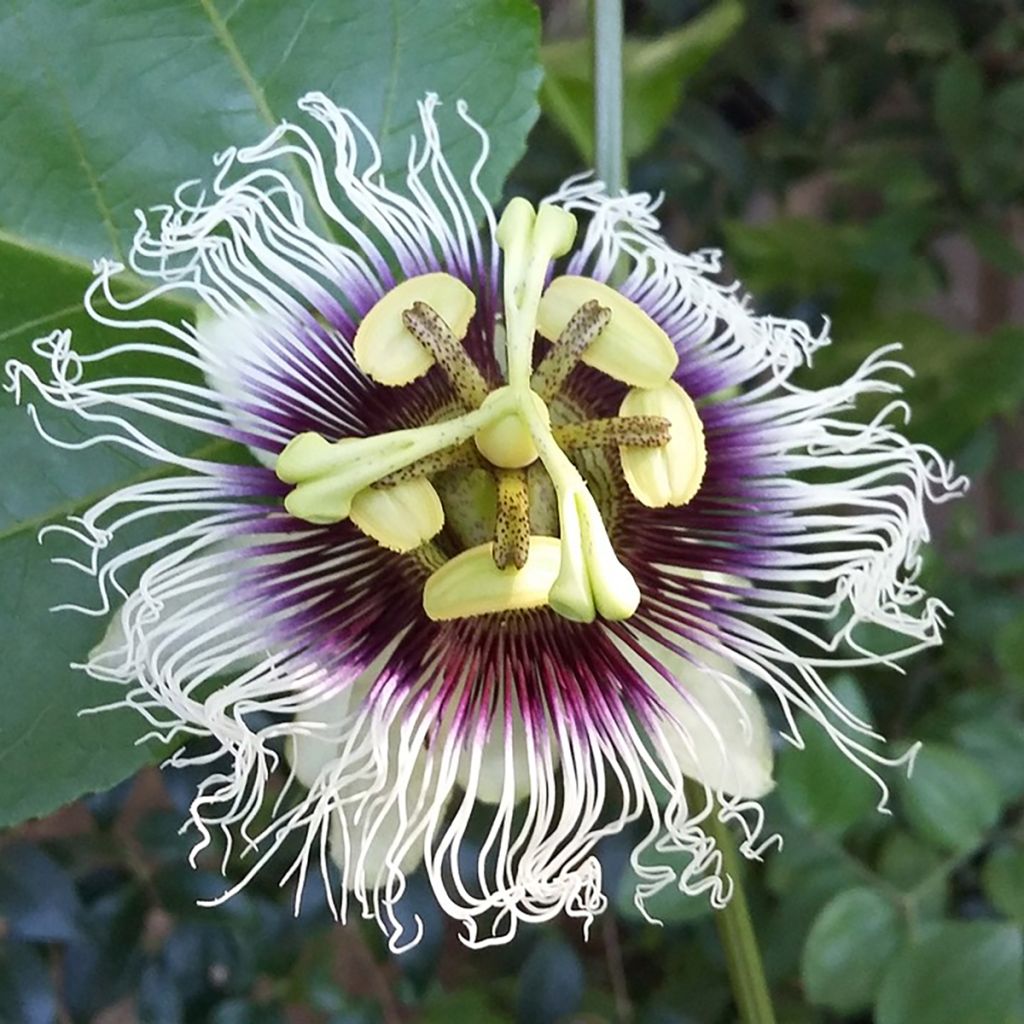

Passiflora edulis f. flavicarpa
Passiflora edulis f. flavicarpa
Passiflora edulis f. flavicarpa
Yellow Passionfruit, Golden Passionfruit
Why not try an alternative variety in stock?
View all →This plant carries a 6 months recovery warranty
More information
We guarantee the quality of our plants for a full growing cycle, and will replace at our expense any plant that fails to recover under normal climatic and planting conditions.
From €5.90 for pickup delivery and €6.90 for home delivery
Express home delivery from €8.90.
Does this plant fit my garden?
Set up your Plantfit profile →
Description
The Yellow Passion Fruit or Passiflora edulis f. flavicarpa produces the fruit called maracuja or yellow passion fruit. It is distinguished from Passiflora edulis f.edulis with its deep purple fruits simply called grenadilles or passion fruits. This semi-woody climber, although offering ornamental qualities, is mainly cultivated for its edible fruits with orange, gelatinous and sweet pulp, very rich in vitamins A and C.
It is sensitive to temperatures below 0°C, so it is best to grow it in a container to enjoy it. This botanical species produces fragrant white flowers in summer, which give way to large ovoid yellow-green fruits, slightly more acidic than the purple fruits. This passion flower requires well-drained, not too dry soil that is not too wet in winter and heat in summer to flower.
Mostly native to tropical areas of South America, passion flowers belong to the large family of Passifloraceae, which includes 400 species and numerous spontaneous or horticultural hybrids. Passiflora edulis f.flavicarpa is a botanical species native to Brazil, Argentina, Venezuela, Colombia, and Paraguay.
The yellow passion fruit is a very vigorous climbing plant that clings to its support with tendrils, reaching an average height of 4 m with a spread of up to 10 m! It is characterised by its semi-woody stems adorned with evergreen, 20 cm long, bright green and shiny leaves, divided into 3 thick, egg-shaped lobes with toothed margins. It flowers all summer with flowers measuring an average of 7 cm in diameter that constantly renew themselves on the plant. They are solitary, pleasantly fragrant and formed by white tepals topped with a crown of white filaments, purple at their base. The flowers of this self-sterile variety require cross-pollination, and therefore the presence of another passion flower nearby to produce its fruits. The egg-shaped, 5 to 8 cm diameter fruits, have a sweet and tangy flavour, emitting a delicious exotic fragrance. They should be harvested when the skin is slightly wrinkled at the end of summer, from August to October. The juicy and gelatinous pulp (aril) contains numerous black seeds.
Passion fruits can be eaten raw, in juice, ice cream, mousse, fruit salads, or simply on their own, cut in half and enjoyed with a spoon. They are renowned for their numerous virtues: antioxidant, rich in vitamins A and C, potassium, fibre, and flavonoids.
This passion fruit requires rich, light, well-drained, humus-bearing soil that remains moist, especially in summer. It is best planted in the sun, in a warm and sheltered location: it needs heat to ensure good fruiting. Be careful, it is frost-sensitive. We therefore recommend growing it in a pot on a terrace or veranda, which can be brought indoors when temperatures drop below 5°C. Provide a trellis or structure to allow it to spread easily. Water abundantly in summer. Prune in spring by cutting the stems back to 20 cm from the ground.
Report an error about the product description
Passiflora edulis f. flavicarpa in pictures
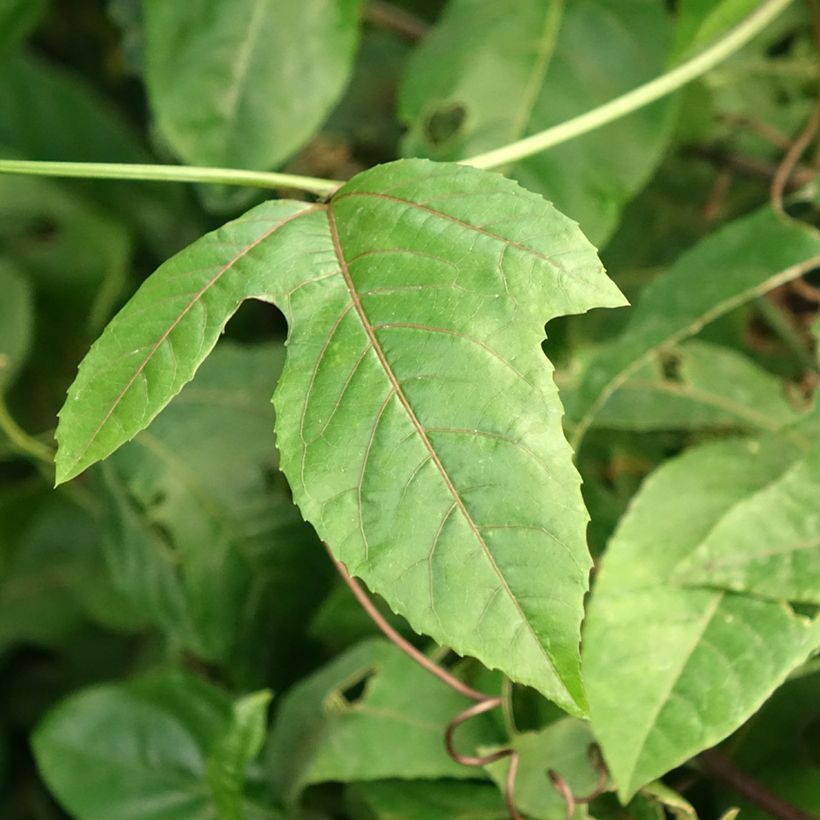

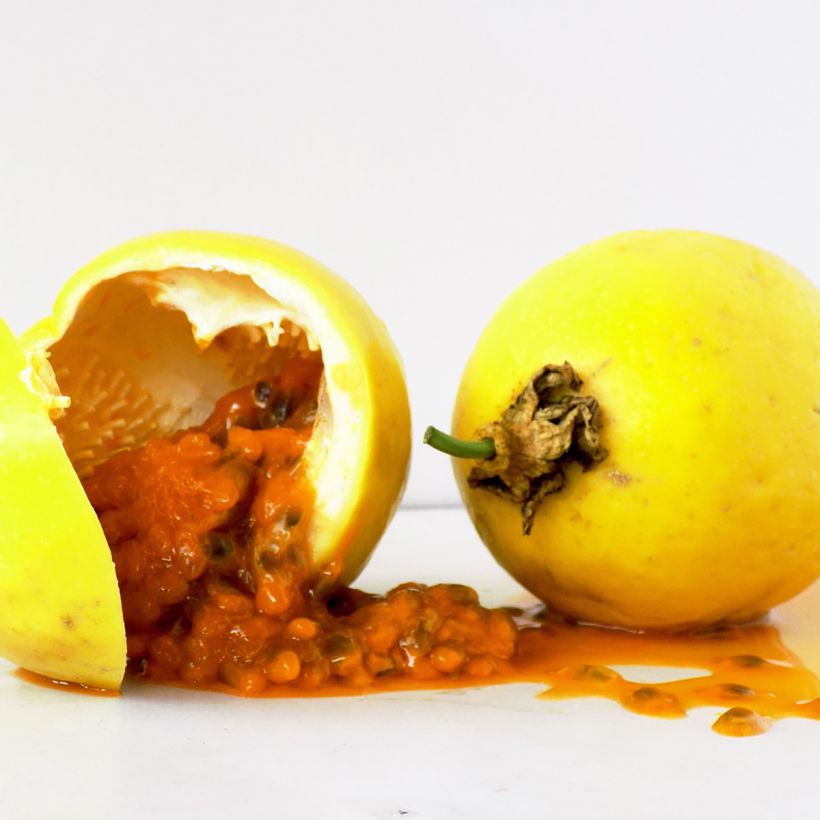

Plant habit
Flowering
Foliage
Botanical data
Passiflora
edulis f. flavicarpa
Passifloraceae
Yellow Passionfruit, Golden Passionfruit
South America
Other Passionflowers
Planting and care
Plant the Yellow Passionfruit in spring.
Choose a very sunny exposure and a sheltered location. The Passionfruit thrives in rich, well-drained, light and moist soils. It is frost-sensitive, so only plant it in open ground in warm climates, elsewhere plant it in a pot to be stored in winter.
In open ground: Dig a hole and mix the garden soil with compost and well-rotted soil. Place the root ball and cover it with soil, firm down well. Water generously throughout the summer. Place mulch at the base to keep it moist in summer and protect it from the cold in winter.
In a pot: place a layer of gravel or clay balls at the bottom of the pot to aid drainage. Fill the pot with a mixture of potting soil, garden soil and compost. Place the root ball and cover with soil. Firm down well and water generously. At the end of autumn, bring the pot indoors to a bright and frost-free location. Repot every 3 years. Water generously throughout the summer.
Passionfruit is susceptible to some diseases, such as cucumber mosaic virus, as well as whiteflies, scale insects and red spider mite.
Planting period
Intended location
Care
This item has not been reviewed yet - be the first to leave a review about it.
Mediterranean climbers
Haven't found what you were looking for?
Hardiness is the lowest winter temperature a plant can endure without suffering serious damage or even dying. However, hardiness is affected by location (a sheltered area, such as a patio), protection (winter cover) and soil type (hardiness is improved by well-drained soil).

Photo Sharing Terms & Conditions
In order to encourage gardeners to interact and share their experiences, Promesse de fleurs offers various media enabling content to be uploaded onto its Site - in particular via the ‘Photo sharing’ module.
The User agrees to refrain from:
- Posting any content that is illegal, prejudicial, insulting, racist, inciteful to hatred, revisionist, contrary to public decency, that infringes on privacy or on the privacy rights of third parties, in particular the publicity rights of persons and goods, intellectual property rights, or the right to privacy.
- Submitting content on behalf of a third party;
- Impersonate the identity of a third party and/or publish any personal information about a third party;
In general, the User undertakes to refrain from any unethical behaviour.
All Content (in particular text, comments, files, images, photos, videos, creative works, etc.), which may be subject to property or intellectual property rights, image or other private rights, shall remain the property of the User, subject to the limited rights granted by the terms of the licence granted by Promesse de fleurs as stated below. Users are at liberty to publish or not to publish such Content on the Site, notably via the ‘Photo Sharing’ facility, and accept that this Content shall be made public and freely accessible, notably on the Internet.
Users further acknowledge, undertake to have ,and guarantee that they hold all necessary rights and permissions to publish such material on the Site, in particular with regard to the legislation in force pertaining to any privacy, property, intellectual property, image, or contractual rights, or rights of any other nature. By publishing such Content on the Site, Users acknowledge accepting full liability as publishers of the Content within the meaning of the law, and grant Promesse de fleurs, free of charge, an inclusive, worldwide licence for the said Content for the entire duration of its publication, including all reproduction, representation, up/downloading, displaying, performing, transmission, and storage rights.
Users also grant permission for their name to be linked to the Content and accept that this link may not always be made available.
By engaging in posting material, Users consent to their Content becoming automatically accessible on the Internet, in particular on other sites and/or blogs and/or web pages of the Promesse de fleurs site, including in particular social pages and the Promesse de fleurs catalogue.
Users may secure the removal of entrusted content free of charge by issuing a simple request via our contact form.
The flowering period indicated on our website applies to countries and regions located in USDA zone 8 (France, the United Kingdom, Ireland, the Netherlands, etc.)
It will vary according to where you live:
- In zones 9 to 10 (Italy, Spain, Greece, etc.), flowering will occur about 2 to 4 weeks earlier.
- In zones 6 to 7 (Germany, Poland, Slovenia, and lower mountainous regions), flowering will be delayed by 2 to 3 weeks.
- In zone 5 (Central Europe, Scandinavia), blooming will be delayed by 3 to 5 weeks.
In temperate climates, pruning of spring-flowering shrubs (forsythia, spireas, etc.) should be done just after flowering.
Pruning of summer-flowering shrubs (Indian Lilac, Perovskia, etc.) can be done in winter or spring.
In cold regions as well as with frost-sensitive plants, avoid pruning too early when severe frosts may still occur.
The planting period indicated on our website applies to countries and regions located in USDA zone 8 (France, United Kingdom, Ireland, Netherlands).
It will vary according to where you live:
- In Mediterranean zones (Marseille, Madrid, Milan, etc.), autumn and winter are the best planting periods.
- In continental zones (Strasbourg, Munich, Vienna, etc.), delay planting by 2 to 3 weeks in spring and bring it forward by 2 to 4 weeks in autumn.
- In mountainous regions (the Alps, Pyrenees, Carpathians, etc.), it is best to plant in late spring (May-June) or late summer (August-September).
The harvesting period indicated on our website applies to countries and regions in USDA zone 8 (France, England, Ireland, the Netherlands).
In colder areas (Scandinavia, Poland, Austria...) fruit and vegetable harvests are likely to be delayed by 3-4 weeks.
In warmer areas (Italy, Spain, Greece, etc.), harvesting will probably take place earlier, depending on weather conditions.
The sowing periods indicated on our website apply to countries and regions within USDA Zone 8 (France, UK, Ireland, Netherlands).
In colder areas (Scandinavia, Poland, Austria...), delay any outdoor sowing by 3-4 weeks, or sow under glass.
In warmer climes (Italy, Spain, Greece, etc.), bring outdoor sowing forward by a few weeks.

































